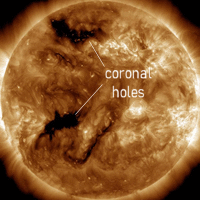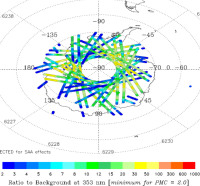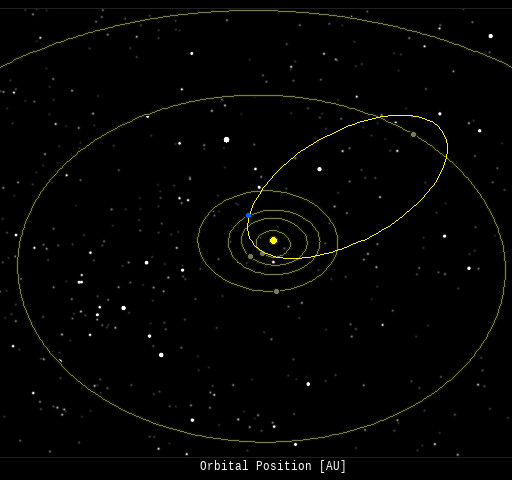 | | | Switch to: Europe, USA, New Zealand, Antarctica Credit: NOAA/Ovation  Planetary K-index Planetary K-index
Now: Kp= 1.67 quiet
24-hr max: Kp= 2.33 quiet
explanation | more data
Interplanetary Mag. Field
Btotal: 6.09 nT
Bz: -1.69 nT south
more data: ACE, DSCOVR
Updated: Today at 1147 UT  Coronal Holes: 25 Jan 24 Coronal Holes: 25 Jan 24 
A twin stream of solar wind flowing from these coronal holes should reach Earth on Jan. 29-30. Credit: SDO/AIA  Polar Stratospheric Clouds
Colorful Type II polar stratospheric clouds (PSC) form when the temperature in the stratosphere drops to a staggeringly low -85C. NASA's MERRA-2 climate model predicts when the air up there is cold enough: 
On Jan. 25, 2024, the Arctic stratosphere is cooling but is not yet cold enough for Type II polar stratospheric clouds. | more data. Noctilucent Clouds
The southern season for NLCs is underway. The first clouds were detected inside the Antarctic Circle on Dec. 4th by the NOAA 21 satellite. An instrument onboard NOAA 21 (OMPS LP) is able to detect NLCs (also known as "polar mesospheric clouds" or PMCs). For the rest of the season, daily maps from NOAA 21 will be presented here:

Updated: Jan 25, 2024
Each dot is a detected cloud. As the season progresses, these dots will multiply in number and shift in hue from blue to red as the brightness of the clouds intensifies.
 SPACE WEATHER
NOAA Forecasts | | Updated at: 2024 Jan 25 2200 UTC FLARE | 0-24 hr | 24-48 hr | CLASS M | 45 % | 45 % | CLASS X | 10 % | 05 % |  Geomagnetic Storms: Geomagnetic Storms:
Probabilities for significant disturbances in Earth's magnetic field are given for three activity levels: active, minor storm, severe storm Updated at: 2024 Jan 25 2200 UTC Mid-latitudes | 0-24 hr | 24-48 hr | ACTIVE | 35 % | 30 % | MINOR | 20 % | 15 % | SEVERE | 05 % | 01 % | High latitudes | 0-24 hr | 24-48 hr | ACTIVE | 15 % | 15 % | MINOR | 20 % | 20 % | SEVERE | 30 % | 30 % | | | |  | | | | | | | | | | | This is an AI Free Zone! Text created by ChatGPT and other Large Language Models is spreading rapidly across the Internet. It's well-written, artificial, frequently inaccurate. If you find a mistake on Spaceweather.com, rest assured it was made by a real human being. | | | GEOMAGNETIC STORM WATCH EXTENDED: NOAA forecasters continue to believe that minor G1-class geomagnetic storms are possible this week when one or more CMEs might graze Earth's magnetic field. The most likely date is Jan. 26th. High-latitude sky watchers should be alert for auroras as the weekend approaches. CME impact alerts: SMS Text A STREETMAP IN THE SKY: To understand this story, you have to understand light pillars. Here are some examples. During winter months, ice crystals in the air catch the glow of urban street lights, creating narrow beams that lance up toward the night sky. On Jan. 16th, dozens of light pillars sprung up from downtown Jyväskylä, Finland. Resident Harri Kiiskinen was ready to photograph them, but instead of pointing his camera sideways at the pillars, as most photographers do, he pointed his camera straight up. This is what he saw: 
"It was 25 degrees below zero in Jyväskylä, and light pillars were visible for several hours," says Kiiskinen. "They drew a map of street lights in the sky." The display went on for hours as ice drifted through the frigid air. This gave Kiiskinen an opportunity to do something unusual: He captured an all-night timelapse of the phenomenon. Play the movie! If you watch the whole thing, you'll never get lost in Jyväskylä.... Realtime Space Weather Photo Gallery
Free: Spaceweather.com Newsletter THE VALENTINE'S SPACE BOUQUET: Just in time for Valentine's Day--the biggest batch of crystal roses ever flown to space! On Jan. 13th, the students of Earth to Sky Calculus launched this 4-flower bouquet to the stratosphere. Floating on a cosmic ray balloon, it rose (no pun intended) to an altitude 109,252 feet above the Sierra Nevada of central California: 
You can have them for $179.95. The students are selling space roses to fund their cosmic ray ballooning program. The flowers, stems and base are all made of Borosilicate Crown Crystal, the kind used in high-quality lenses and prisms. That's why the flowers glitter so colorfully in sunlight at the edge of space. Each purchase comes with a greeting card showing the bouquet in flight and telling the story of its journey to the stratosphere and back again.
Far Out Gifts: Earth to Sky Store
All sales support hands-on STEM education
Realtime Aurora Photo Gallery
Free: Spaceweather.com Newsletter
Realtime Comet Photo Gallery
Free: Spaceweather.com Newsletter Every night, a network of NASA all-sky cameras scans the skies above the United States for meteoritic fireballs. Automated software maintained by NASA's Meteoroid Environment Office calculates their orbits, velocity, penetration depth in Earth's atmosphere and many other characteristics. Daily results are presented here on Spaceweather.com. On Jan 25, 2024, the network reported 2 fireballs.
(2 sporadics)  In this diagram of the inner solar system, all of the fireball orbits intersect at a single point--Earth. The orbits are color-coded by velocity, from slow (red) to fast (blue). [Larger image] [movies] Potentially Hazardous Asteroids ( PHAs) are space rocks larger than approximately 100m that can come closer to Earth than 0.05 AU. None of the known PHAs is on a collision course with our planet, although astronomers are finding new ones all the time. On January 25, 2024 there were 2349 potentially hazardous asteroids.
 | Recent & Upcoming Earth-asteroid encounters: | Asteroid | Date(UT) | Miss Distance | Velocity (km/s) | Diameter (m) | | 2024 BC | 2024-Jan-20 | 2.2 LD | 18.9 | 13 | | 2024 BQ1 | 2024-Jan-20 | 0.9 LD | 6.6 | 4 | | 2024 BL | 2024-Jan-20 | 4.7 LD | 18.8 | 13 | | 2024 BE1 | 2024-Jan-21 | 2.1 LD | 9.8 | 6 | | 2024 BM | 2024-Jan-22 | 7.9 LD | 6 | 14 | | 2024 BR2 | 2024-Jan-22 | 0.8 LD | 4 | 13 | | 2024 BG2 | 2024-Jan-22 | 1.4 LD | 31.6 | 14 | | 2024 BA1 | 2024-Jan-23 | 8.5 LD | 6.4 | 14 | | 2021 BL3 | 2024-Jan-23 | 17.2 LD | 23.4 | 41 | | 2024 AL6 | 2024-Jan-24 | 5.5 LD | 27 | 26 | | 2017 BG92 | 2024-Jan-25 | 11.8 LD | 6.3 | 6 | | 2011 CQ1 | 2024-Jan-26 | 11.3 LD | 4.6 | 1 | | 2024 BJ | 2024-Jan-27 | 0.9 LD | 6.3 | 22 | | 2024 BF1 | 2024-Jan-27 | 10.5 LD | 26.1 | 82 | | 2024 AU4 | 2024-Jan-28 | 16.5 LD | 17.4 | 83 | | 2024 AT1 | 2024-Jan-30 | 20 LD | 21.4 | 150 | | 2007 EG | 2024-Jan-30 | 16 LD | 8.6 | 43 | | 2003 BM4 | 2024-Feb-01 | 8.7 LD | 10.9 | 37 | | 2024 BY | 2024-Feb-01 | 6.6 LD | 5.4 | 19 | | 2008 OS7 | 2024-Feb-02 | 7.5 LD | 18.2 | 285 | | 2024 BP1 | 2024-Feb-02 | 8.9 LD | 7.2 | 41 | | 2019 CC5 | 2024-Feb-04 | 19.2 LD | 15 | 139 | | 2024 BO | 2024-Feb-06 | 19.9 LD | 6.1 | 32 | | 2023 SP1 | 2024-Feb-07 | 14.3 LD | 11.8 | 256 | | 2024 BH | 2024-Feb-10 | 18.4 LD | 8.1 | 77 | | 2020 DK | 2024-Feb-12 | 8.9 LD | 9.9 | 22 | | 2024 AO | 2024-Feb-16 | 9.3 LD | 7.3 | 53 | | 2019 DA1 | 2024-Mar-03 | 14.6 LD | 13.4 | 22 | | 2015 FM34 | 2024-Mar-12 | 19.4 LD | 11.1 | 113 | | 2020 FU | 2024-Mar-15 | 14.9 LD | 15.5 | 19 | | 2020 FD | 2024-Mar-18 | 4.5 LD | 15.1 | 10 | | 2019 CJ | 2024-Mar-24 | 12.4 LD | 4.4 | 30 | Notes: LD means "Lunar Distance." 1 LD = 384,401 km, the distance between Earth and the Moon. 1 LD also equals 0.00256 AU. | | Cosmic Rays in the Atmosphere | SPACE WEATHER BALLOON DATA: Almost once a week, Spaceweather.com and the students of Earth to Sky Calculus fly space weather balloons to the stratosphere over California. These balloons are equipped with sensors that detect secondary cosmic rays, a form of radiation from space that can penetrate all the way down to Earth's surface. Our monitoring program has been underway without interruption for 7 years, resulting in a unique dataset of in situ atmospheric measurements. Latest results (July 2022): Atmospheric radiation is decreasing in 2022. Our latest measurements in July 2022 registered a 6-year low: 
What's going on? Ironically, the radiation drop is caused by increasing solar activity. Solar Cycle 25 has roared to life faster than forecasters expected. The sun's strengthening and increasingly tangled magnetic field repels cosmic rays from deep space. In addition, solar coronal mass ejections (CMEs) sweep aside cosmic rays, causing sharp reductions called "Forbush Decreases." The two effects blend together to bring daily radiation levels down. .Who cares? Cosmic rays are a surprisingly "down to Earth" form of space weather. They can alter the chemistry of the atmosphere, trigger lightning, and penetrate commercial airplanes. According to a study from the Harvard T.H. Chan school of public health, crews of aircraft have higher rates of cancer than the general population. The researchers listed cosmic rays, irregular sleep habits, and chemical contaminants as leading risk factors. A number of controversial studies (#1, #2, #3, #4) go even further, linking cosmic rays with cardiac arrhythmias and sudden cardiac death. Technical notes: The radiation sensors onboard our helium balloons detect X-rays and gamma-rays in the energy range 10 keV to 20 MeV. These energies span the range of medical X-ray machines and airport security scanners. Data points in the graph labeled "Stratospheric Radiation" correspond to the peak of the Regener-Pfotzer maximum, which lies about 67,000 feet above central California. When cosmic rays crash into Earth's atmosphere, they produce a spray of secondary particles that is most intense at the entrance to the stratosphere. Physicists Eric Regener and Georg Pfotzer discovered the maximum using balloons in the 1930s and it is what we are measuring today. | | The official U.S. government space weather bureau | | | The first place to look for information about sundogs, pillars, rainbows and related phenomena. | | | Researchers call it a "Hubble for the sun." SDO is the most advanced solar observatory ever. | | | 3D views of the sun from NASA's Solar and Terrestrial Relations Observatory | | | Realtime and archival images of the Sun from SOHO. | | | information about sunspots based on the latest NOAA/USAF Active Region Summary | | | current counts of failed and deployed Starlink satellites from Jonathan's Space Page | | | Authoritative predictions of space junk and satellite re-entries | | | from the NOAA Space Environment Center | | | fun to read, but should be taken with a grain of salt! Forecasts looking ahead more than a few days are often wrong. | | | from the NOAA Space Environment Center | | | the underlying science of space weather |  | When looking for casinos to play online when the weather is bad, you can try the SkyCity Online Casino if you are located in New Zealand. If you are not from NZ you can try the Swedish page Svenska casino online to find suitable games, check out svenskacasinoonline.net. Always check your local laws before playing with real money.. |  | BestCSGOGambling is the best site for everything related to CSGO gambling on the web | | | These links help Spaceweather.com stay online. Thank you to our supporters! | | | | | | | | |  | |  |   | ©2021 Spaceweather.com. All rights reserved. This site is penned daily by Dr. Tony Phillips. | |

